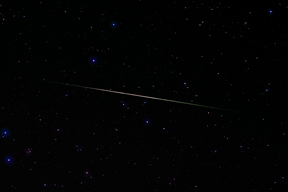Meteor showers are actually related to comets. As a comet approaches the Sun, it starts to melt which forms the bright coma and tail. The tail leaves debris behind that, if they cross Earth's path, the planet will run into and we will see a meteor shower.
Meteor showers are named for the constellation from which they appear to come. For example, the Leonids appear to radiate from a point in space in the constellation Leo. To photograph them, you need a wide-angle camera and a lot of luck. Although they're called "showers," peak rates usually max out at maybe 1-2 per minute, and many are more like 20 per hour.
Perseid Meteor Shower - 2007

Click Image for Larger Version
This was the first astrophoto test with my new Canon 35 mm f/1.4L camera lens. I went out on the night of August 12, 2007, and set up my camera and lens facing in the general direction of Cassiopeia. I was amazed that even at f/1.8, I was still saturating the image in terms of star brightnesses after around 30 seconds. I stopped it down to around f/2.0 and took ~60-75-second exposures.
Of course, the one single solitary meteor I caught was on my first shot, and I didn't catch anymore that night. Oh well.
| Object | Meteor |
| Common Name | Perseid Meteor |
| Date, Time, & Moon | August 12, 2007; ~10:30 P.M. MDT; No Moon |
| Location | SBO Telescope at CU Boulder |
| Optics | 35 mm lens; f/2.0 |
| Camera | Canon Digital Rebel 350D XT |
| Exposure Details | ~75 seconds; ISO 100 |
| Optical Correction | Dark- and Flatframe-Correction |
| Camera Position | Normal camera operation. |
| Guiding | Passive Clock Drive; Equatorial Mount |
| Processing Details | Adobe PhotoShop - Levels/Curves adjustment |
| Image Size | Several degrees in each dimension. |
| Magnitude Depth | Unknown |
| Notes | My first meteor shower that I attempted to photograph. |